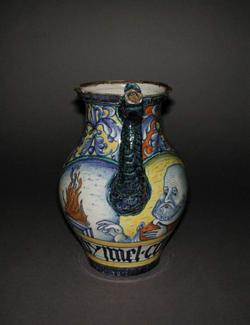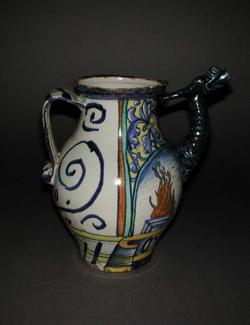Current Location: In storage
Maker(s)
Workshop:
Pompei workshop
Entities
Categories
Description
Maiolica spouted pharmacy jar, painted in blue, green, yellow, and orange, with a bust of a bearded old man, the inscription of the drug `Oymel composito', loose spirals, stripes, and honeysuckle.
Earthenware, tin-glazed except for the base. Painted in blue, green, yellow, and orange. Dragon-spouted baluster jar with strap handle.The spout is surrounded by a truncated heart-shaped panel, enclosing a bust of a bearded old man three-quarters to left, pointing with his right hand to a flaming brazier. The space above is filled by blue and white honeysuckle on a partly yellow and partly orange ground, bordered by two vertical stripes: green and orange on the left of the spout, and green and yellow on the right. The drug name `Oymel composito' is inscribed in gothic letters on a label with curled ends between yellow horizontal bands which encircle the lower part of the jar. On the back there are loose blue spirals, and on the handle and between the ends of the label, blue diagonal stripes. The projecting rim is decorated with orange scallops on a dark blue band with a pale green band below.
Notes
History note: A. Wylie; F. Leverton Harris (1864-1926)
Legal notes
F. Leverton Harris Bequest, 1926
Measurements and weight
Height: 25.9 cm
Acquisition and important dates
Method of acquisition: Bequeathed
(1927)
by
Harris, Frederick Leverton
Dating
16th Century, Mid
Renaissance
Circa
1545
CE
-
1555
CE
Note
During the fifteenth and sixteenth century many pharmacies in Italian towns had extensive sets of maiolica jars of different forms to contain the various medicaments, and from the early sixteenth century, these often had their contents name painted on labels which were part of the decoration. These inscriptions frequently used the specialised Latin vocabulary of published medical texts and ‘books of secrets’. Spouted jars were used for oils, syrups, or liquid infusions. This one is labelled: ‘O[x]ymel composito’ compound oxymel, a potion prepared by evaporating a mixture of clarified honey and vinegar until it formed a syrup. This sweet- and-sour concoction, known from ancient Roman sources, was used to treat asthma as well as conjunctivitis. The warming nature of the remedy is alluded to by the old man who points to a flaming brazier, an image often emblematic of Winter.
The jar and C.65-1927 belong to a group of at least 280 pharmacy of several different forms with closely related and very distinctive decoration. The ceramic historian, Bernard Rackham (1876-1964), named the type 'Orsini-Colonna' jars, because a large two-handled bottle in the British Museum is decorated with a bear embracing a column with the words 'ET SARRIMO boNI AMICI' (and we will be good friends), emblematic of a reconciliation between these rival Roman families. The Orsini jars might be more appropriate, as that family's arms appear on a two-handled vase in the Lehman collection in the Metropolitan Museum of Art, New York, and on a two-handled bottle in a private collection. However, as more jars became known, it became apparent that the contents labels were repeated two, three, four, or in two instances five times, indicating that there must have been several different sets. This is also supported by the use of Roman capitals for the labels on some jars, and Gothic lettering on others.
In the absence of firm evidence for their place of origin the jars used to be attributed to central Italian towns, including Deruta, Siena, Cafaggiolo, Faenza or Casteldurante. Their secure attribution to Castelli in the Abruzzi followed the retrieval of many similar fragments in an excavation there between 1980 and 1982. This revealed the waste tip on the hillside behind the house of Orazio Pompei (c. 1510-20 to after 1590), a member of a large and flourishing potting family in the town. The connection between Orazio and the jars is supported by the inscription 'OC/OPVS/ORATII' on a dragon-spouted ewer in the Museo Internazionale delle Ceramiche, Faenza, and by similarities between the female busts on the jars, and those on two maiolica panels attributed to him. The first, decorated with the Virgin and Child flanked by the letters 'ORO', presumably for Orazio, and the date '1551' was formerly situated at the entrance to his house. The second, decorated with the Annunciation, and dated '21.MAI/1557' belongs to the comune of Chieti. Given Orazio's presumed date of birth, it seems unlikely that the pharmacy jars were made before about 1540 and judging by their similarities with the figures in the wall panels, production could have continued until the late 1550s. Vincenzo De Pompeis considered that this jar was probably made at the early end of the date range. (see Documentation, 1990)
School or Style
Renaissance
People, subjects and objects depicted
Components of the work
Decoration
composed of
high-temperature colours
( blue, green, yellow, and orange)
Base
Diameter 10.3 cm
Rim
Diameter 12.1 cm
Widest Part
Width 23.5 cm
Body
Spout
Materials used in production
except base
Tin-glaze
Earthenware
Techniques used in production
Tin-glazing
Inscription or legends present
- Text: Oymel composito
- Location: On lower part of jug
- Method of creation: Painted in Gothic letters
- Type: Inscription
References and bibliographic entries
Related exhibitions
Identification numbers
Accession number: C.64-1927
Primary reference Number: 75726
Stable URI
Audit data
Created: Saturday 6 August 2011
Updated: Friday 1 August 2025
Last processed: Friday 1 August 2025
Associated departments & institutions
Owner or interested party:
The Fitzwilliam Museum
Associated department:
Applied Arts








